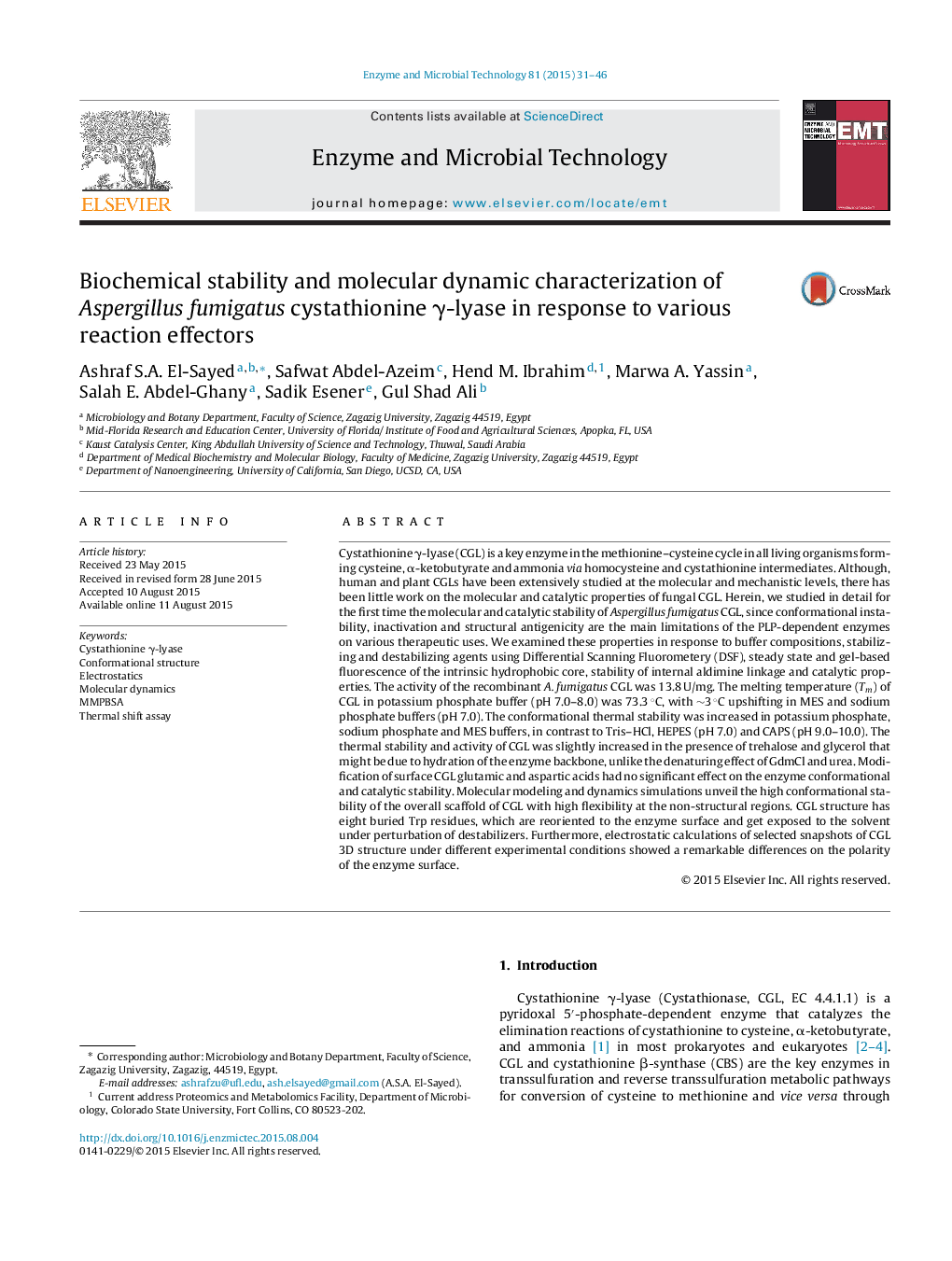| کد مقاله | کد نشریه | سال انتشار | مقاله انگلیسی | نسخه تمام متن |
|---|---|---|---|---|
| 6488250 | 42624 | 2015 | 16 صفحه PDF | دانلود رایگان |
عنوان انگلیسی مقاله ISI
Biochemical stability and molecular dynamic characterization of Aspergillus fumigatus cystathionine γ-lyase in response to various reaction effectors
دانلود مقاله + سفارش ترجمه
دانلود مقاله ISI انگلیسی
رایگان برای ایرانیان
کلمات کلیدی
موضوعات مرتبط
مهندسی و علوم پایه
مهندسی شیمی
بیو مهندسی (مهندسی زیستی)
پیش نمایش صفحه اول مقاله

چکیده انگلیسی
Cystathionine γ-lyase (CGL) is a key enzyme in the methionine-cysteine cycle in all living organisms forming cysteine, α-ketobutyrate and ammonia via homocysteine and cystathionine intermediates. Although, human and plant CGLs have been extensively studied at the molecular and mechanistic levels, there has been little work on the molecular and catalytic properties of fungal CGL. Herein, we studied in detail for the first time the molecular and catalytic stability of Aspergillus fumigatus CGL, since conformational instability, inactivation and structural antigenicity are the main limitations of the PLP-dependent enzymes on various therapeutic uses. We examined these properties in response to buffer compositions, stabilizing and destabilizing agents using Differential Scanning Fluorometery (DSF), steady state and gel-based fluorescence of the intrinsic hydrophobic core, stability of internal aldimine linkage and catalytic properties. The activity of the recombinant A. fumigatus CGL was 13.8 U/mg. The melting temperature (Tm) of CGL in potassium phosphate buffer (pH 7.0-8.0) was 73.3 °C, with â¼3 °C upshifting in MES and sodium phosphate buffers (pH 7.0). The conformational thermal stability was increased in potassium phosphate, sodium phosphate and MES buffers, in contrast to Tris-HCl, HEPES (pH 7.0) and CAPS (pH 9.0-10.0). The thermal stability and activity of CGL was slightly increased in the presence of trehalose and glycerol that might be due to hydration of the enzyme backbone, unlike the denaturing effect of GdmCl and urea. Modification of surface CGL glutamic and aspartic acids had no significant effect on the enzyme conformational and catalytic stability. Molecular modeling and dynamics simulations unveil the high conformational stability of the overall scaffold of CGL with high flexibility at the non-structural regions. CGL structure has eight buried Trp residues, which are reoriented to the enzyme surface and get exposed to the solvent under perturbation of destabilizers. Furthermore, electrostatic calculations of selected snapshots of CGL 3D structure under different experimental conditions showed a remarkable differences on the polarity of the enzyme surface.
ناشر
Database: Elsevier - ScienceDirect (ساینس دایرکت)
Journal: Enzyme and Microbial Technology - Volume 81, December 2015, Pages 31-46
Journal: Enzyme and Microbial Technology - Volume 81, December 2015, Pages 31-46
نویسندگان
Ashraf S.A. El-Sayed, Safwat Abdel-Azeim, Hend M. Ibrahim, Marwa A. Yassin, Salah E. Abdel-Ghany, Sadik Esener, Gul Shad Ali,